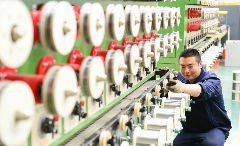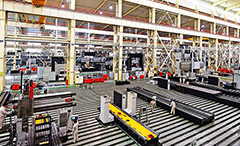China’s economic and social development in 2016
2017-02-28
Xinhua
BEIJING — China’s National Bureau of Statistics (NBS) on Feb 28 released a report on the country’s economic and social development in 2016.
NBS deputy chief Li Xiaochao said that the report highlighted stable economic growth, an elevation of growth quality, steady jobs growth and progress in quality of life.
The following are some important figures on China’s social and economic development in 2016:
— China’s gross domestic product expanded 6.7 percent year on year to 74.41 trillion yuan ($10.82 trillion).
— Total population stood at 1.383 billion at the end of 2016, 8.09 million more than at the end of 2015.
— The urban population was 792.98 million, accounting for 57.35 percent of the total.
— By the end of the year, 776.03 million people were employed, including 414.28 million people employed in cities.
— A total of 13.14 million new jobs were created in cities. The registered urban unemployment rate was 4.02 percent at the end of the year.
— The number of rural migrant workers increased 1.5 percent year on year to 281.71 million at the end of 2016.
— The consumer price index, the main gauge of inflation, rose 2 percent year on year.
— In December 2016, 65 cities in a statistical pool of 70 large and medium-sized cities tracked by the NBS saw new residential house price gains year on year, while five cities witnessed new residential house price declines year on year.
— China’s fiscal revenues grew 4.5 percent year on year to 15.96 trillion yuan. Tax revenues contributed 13.04 trillion yuan, an increase of 4.3 percent year on year.
— China’s foreign exchange reserves totaled $3.01 trillion at the end of the year, a decrease of $319.8 billion year on year.
— The grain crop area in China totaled 113.03 million hectares, a decrease of 310,000 hectares from a year earlier.
— China’s grain output decreased 0.8 percent from a year earlier to 616.24 million tonnes.
— Industrial value-added output rose 6 percent from a year earlier to 24.79 trillion yuan.
— Fixed asset investment rose 7.9 percent year on year to 60.65 trillion yuan.
— Investment in real estate development hit 10.26 trillion yuan, up 6.9 percent year on year.
— Retail sales of consumer goods rose 10.4 percent to 33.23 trillion yuan. Sales in urban areas grew 10.4 percent. In rural areas growth was 10.9 percent.
— Online sales of consumer goods soared 26.2 percent from the previous year to 5.16 trillion yuan.
— Total goods trade volume dropped 0.9 percent year on year to 24.34 trillion yuan. The goods trade surplus stood at 3.35 trillion yuan, down 330.8 billion yuan from a year earlier.
— China’s combined imports and exports with countries along the Belt and Road topped 6.3 trillion yuan. The Belt and Road Initiative, proposed by China in 2013, aims to build a trade and infrastructure network connecting Asia with Europe and Africa along the ancient Silk Road trade routes.
— Foreign direct investment into China climbed 4.1 percent to $126 billion.
— China’s broad money supply, which covers cash in circulation and all deposits, increased 11.3 percent from a year earlier to 155 trillion yuan.
— The narrow measure of money supply, which covers cash in circulation plus money in current corporate deposits, climbed 21.4 percent to 48.7 trillion yuan.
— Urban residents’ per capita disposable income expanded 7.8 percent year on year to 33,616 yuan.
— Per capita disposable income of rural residents rose 8.2 percent year on year to 12,363 yuan.
— Research and development expenditure increased 9.4 percent year on year to 1.55 trillion yuan, accounting for 2.08 percent of GDP.


